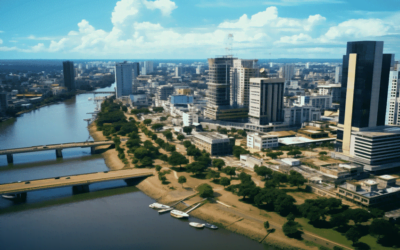Hey there, fellow drone enthusiasts and curious readers, are you pondering over the rules and regulations governing drone use in Denmark? It’s a question that’s been on the minds of many.
As someone who’s explored the world of Denmark’s drone laws and gone the extra mile in researching, I’m here to share the insights I’ve gathered to help you navigate the intricacies of these regulations.
You see, when I delved into the world of Denmark’s drone laws, I encountered a range of perplexing questions, from whether tourists could fly drones to what licenses are needed, and even the essential details about drone registration.
The quest for clarity on these rules was quite the journey, but rest assured, I’ve got the answers you’re seeking.
Curious about how Denmark’s drone laws apply to you? Eager to understand the requirements, limitations, and opportunities they present? Well, you’re in the right place.
In this article, I’ll break down the nuances of Denmark’s drone regulations, demystify the perplexing aspects, and share the burst of insights I’ve collected through extensive research.
So, if you’re looking for a solution to your drone law-related queries, read on, and let’s navigate Denmark’s drone regulations together.
- Drone Laws for Tourists/Foreign Visitors in Denmark
- Drone Laws for Government Operators in Denmark
- Categorization of Drones and Associated Regulations in Denmark
- Denmark Safety and Privacy Considerations
- Consequences of Violating Drone Laws in Denmark
- Denmark Resources for Additional Information
- Final Thoughts on Denmark Drone Laws
- Frequently Asked Questions about Drone Laws in Denmark
Drone Laws for Tourists/Foreign Visitors in Denmark

Let’s dive into the specifics of Denmark’s drone laws for tourists and foreign visitors, where we’ll unravel the essentials of flying a drone in the picturesque Danish landscape.
These regulations are essential to ensure safe and responsible drone use, whether you’re a drone enthusiast exploring new horizons or a traveler capturing the breathtaking Danish scenery from above.
Drone laws for tourists and foreign visitors
Picture this: you’re standing amidst the enchanting landscapes of Denmark, ready to send your drone soaring through the skies. However, before you launch, it’s crucial to understand the rules that govern your flight.
Denmark’s drone laws make it clear that they apply to tourists and foreign visitors, just like they do for residents. So, even if you’re here for a short visit, it’s important to stay informed.
Foreign visitor drone flights Permitted with conditions
The good news is, Denmark welcomes foreign visitors to take to the skies with their drones. However, these freedoms come with certain responsibilities. While you’re free to fly, you must ensure that you abide by the local regulations, respecting the privacy and safety of those on the ground.
It’s like driving in a foreign country; you can do it, but you must adhere to the local traffic rules.
Requirement for a foreign visitor drone pilot license
One vital aspect of Denmark’s drone laws for tourists is the requirement for a drone pilot license. If you’re planning to operate a drone weighing more than 250 grams, it’s time to hit the books, so to speak.
You’ll need to obtain a drone pilot license, and that involves passing a written exam. Think of it as getting a driver’s license before hitting the road, ensuring you know the rules of the game.
Drone registration Mandatory for tourists
Much like a traveler’s passport, your drone also needs proper documentation when in Denmark. While drone registration is mandatory for tourists, there’s a nifty exception. If your drone is already registered with the European Union Aviation Safety Agency (EASA), you’re off the hook.
It’s akin to having a visa-free entry; the local authorities recognize your drone as being in compliance with EU-wide standards.
Drone Remote ID Not required, but recommended for tourists
Imagine your drone as a ship sailing through Danish airspace. While it doesn’t need a flag, it’s recommended to have a beacon that identifies it—enter Drone Remote ID. Although not mandatory for tourists, this technology helps ensure accountability and safety in the skies.
Think of it as a navigation light on your boat; not a must-have, but it makes your presence known.
Drone insurance Recommended for tourist drone operations
As you venture into the Danish skies, it’s prudent to consider insurance for your drone. Though not an absolute requirement, having insurance offers peace of mind. If your drone takes an unexpected nosedive or accidentally captures more than just stunning views, it’s a safety net.
It’s akin to travel insurance; you hope you won’t need it, but it’s a lifesaver when the unexpected occurs.
Also Read: Czech Republic Drone Regulations 2024
Drone Laws for Government Operators in Denmark

Now, let’s turn our attention to the regulations governing drone operations for government entities in Denmark. While tourists and hobbyists have their own set of rules to follow, government drone operators must adhere to a unique set of guidelines to ensure responsible and safe drone usage.
In this section, we’ll explore the world of drone laws specifically tailored to governmental drone operations.
Overview of drone laws for government operators
Imagine being responsible for managing the skies from a government perspective. These regulations are like the air traffic control for government drone operators, ensuring that their activities are conducted with precision and compliance.
Government entities are a vital part of Denmark’s drone landscape, and it’s crucial they abide by the law.
Government drone flights
The skies of Denmark are not limited to tourists and hobbyists alone. Government operators, tasked with missions ranging from surveillance to environmental monitoring, are permitted to take flight. However, their operations come with certain regulations.
It’s somewhat like having access to exclusive lanes on a road, but with the understanding that they must still follow the speed limits and traffic rules.
Government drone pilot license
Just like a commercial pilot’s license is a requirement for operating passenger flights, government drone operators must hold a valid drone pilot license.
This is an essential measure to ensure that those responsible for government drone operations are well-versed in drone regulations and safe practices. It’s comparable to the requirement for a special license to operate specialized vehicles, such as a truck or a tank.
Drone registration Required for government operations
To ensure transparency and accountability, government drone operations in Denmark are required to register their drones. This process allows the authorities to track and manage these specialized devices, similar to how a city keeps records of official vehicles in use.
Remote ID Not mandatory for government drone operations
While Drone Remote ID is recommended for tourists and hobbyists, it’s not mandatory for government drone operations. This approach ensures government entities can carry out their missions with specific operational needs in mind, maintaining a certain level of secrecy if required, while still complying with other aspects of the law.
Insurance Not required for government drone operations
In the realm of government drone operations, insurance is not a mandatory requirement. Given the nature of government missions and their capacity to cover potential liabilities through other means, this exception aligns with their unique responsibilities.
It’s like being self-insured, where the government takes on the financial responsibility for any unforeseen incidents related to drone use.
Also Read: Cyprus Drone Regulations 2024
Categorization of Drones and Associated Regulations in Denmark

Understanding how drones are categorized is like deciphering a roadmap in the sky. It not only guides enthusiasts but also ensures the safety of everyone below.
In Denmark, drones are classified based on their weight and capabilities, each category with its own set of rules. Let’s take a closer look at how these categorizations and regulations shape the drone landscape in this charming Scandinavian country.
Drone categories based on weight and capabilities
Drones, just like cars, come in various sizes and models, each designed for specific purposes. In Denmark, these aerial wonders are divided into categories A1, A2, and A3, with distinctions based on weight and capabilities. A1 drones are the lightweight companions, perfect for recreational flights.
A2 drones offer a bit more flexibility, and A3 drones, the heavyweights of the skies, come with stricter regulations. Think of it as choosing between a bicycle for leisurely rides, a scooter for city exploration, and a heavy truck for transporting goods—each with its own rules to ensure a smooth journey.
Specific rules for each category: A1, A2, and A3
When it comes to drone categories, each has its own unique set of regulations. A1 drones, being the lightest, are allowed to fly in areas close to people, granting enthusiasts the freedom to capture their moments without disturbing the peace.
A2 drones offer a balance, allowing flights in specified areas with a bit more distance from people.
Now, A3 drones, being the heavyweights, have more stringent rules, restricting their flights to areas where the risk to people is minimized. These rules act as guiding stars, ensuring that enthusiasts navigate the skies safely and responsibly.
Altitude limits for drone flights
Imagine the sky as a vertical highway, where each lane has its speed limits. Similarly, drone flights in Denmark have altitude limits to maintain order and safety. Drones, regardless of their category, are generally limited to a maximum height of about 120 meters above ground level.
This restriction ensures that drones stay clear of manned aircraft and other potential hazards in the airspace. It’s like ensuring every vehicle on the road maintains a safe distance from one another, preventing accidents and ensuring a smooth flow of traffic.
No-fly zones and restricted areas
Every sky has its sacred spaces and areas off-limits to drones. These no-fly zones and restricted areas, often surrounding places like airports, military installations, and public events, are crucial for national security and public safety.
In these zones, drone flights are prohibited, akin to respecting the privacy of someone’s home. Understanding and respecting these boundaries ensures that drone enthusiasts can enjoy their hobby while maintaining the safety and security of the broader community.
Also Read: Cuba Drone Regulations 2024
Denmark Safety and Privacy Considerations

Flying a drone is exhilarating, offering a unique perspective on the world below. However, with great freedom comes great responsibility. In Denmark, safety and privacy considerations are paramount, ensuring that both drone enthusiasts and the public can coexist harmoniously.
Let’s delve into the essential aspects of safety and privacy that every drone pilot should be mindful of, creating a sky where everyone feels secure and respected.
Maintaining a visual line of sight while flying
Imagine steering a ship through uncharted waters; your eyes are your guiding stars. Similarly, when flying a drone, maintaining a visual line of sight is your North Star. This means always keeping your drone within your direct line of vision.
It’s like driving a car – you wouldn’t close your eyes while behind the wheel, right? Ensuring you can see your drone allows you to navigate obstacles, avoid collisions, and respond swiftly to unexpected situations.
It’s not just a rule; it’s a fundamental practice that keeps both your drone and the people around you safe.
Night flying regulations and requirements
The allure of capturing the world under a blanket of stars is irresistible, yet night flying introduces a new set of challenges.
In Denmark, night flying is allowed, but it requires additional precautions. Your drone must be equipped with lights visible for at least 500 meters, akin to the navigation lights on ships guiding them in the dark.
This ensures that others can see your drone from afar, preventing surprises and ensuring a clear understanding of its position. Just as a lighthouse guides ships safely to harbor, these lights guide your drone back home.
Respecting privacy and capturing images or videos responsibly
Imagine someone peeking into your home through a window – it’s unsettling, right? Respecting privacy is paramount in the world of drones. When capturing images or videos, it’s crucial to avoid infringing on others’ privacy. Maintain a respectful distance from people and their properties, just as you would expect others to do for you.
Additionally, be cautious when sharing your aerial masterpieces. Always ensure that the content you capture and share is respectful, avoiding images or videos that could invade someone’s personal space. It’s not just about the technology; it’s about the ethical responsibility that comes with capturing moments from above.
Also Read: Croatia Drone Regulations 2024
Consequences of Violating Drone Laws in Denmark

As we soar through the intricacies of Denmark’s drone laws, it’s crucial to understand that these regulations are not merely guidelines; they come with real consequences. Violating drone laws can lead to a series of repercussions that every drone pilot should be aware of.
Let’s take a closer look at the potential fines and legal consequences and why it’s paramount to adhere to these regulations for the sake of safe and responsible drone operations.
Potential fines and legal consequences for violations
The consequences of breaking drone laws in Denmark are akin to the penalties for traffic violations on the ground. Depending on the nature and severity of the violation, drone pilots may face fines ranging from minor infractions to more substantial penalties.
These fines serve as a reminder that, just like cars on the road, drones in the sky must follow the rules to ensure safety and accountability. Violations can also result in legal action, making it a matter of both ethics and law to adhere to these regulations.
Importance of adhering to regulations to ensure safe and responsible drone operations
Consider drone laws as the guardrails along a highway, keeping everyone on the right path. Adhering to these regulations is not just about avoiding fines and legal consequences; it’s about ensuring safe and responsible drone operations.
Staying within the legal framework means reducing risks to people, property, and other aircraft, while also promoting a culture of responsible drone usage.
Just as obeying traffic laws on the road creates safer and more pleasant journeys, following drone laws ensures that the skies remain a secure and welcoming place for all drone enthusiasts.
Also Read: Côte d’Ivoire Drone Regulations 2024
Denmark Resources for Additional Information

Navigating the world of drone laws in Denmark may seem like embarking on a complex journey, but the good news is there are guiding stars along the way. To ensure that you have the most up-to-date information and resources at your fingertips, we’ll explore where to find valuable references and guidance on obtaining licenses, registering drones, and even deciphering NOTAMs (Notice to Airmen). Let’s make sure you’re well-equipped for your drone adventures.
References to official authorities, websites, and resources for staying updated on current drone laws
Consider this as your personal GPS system for the world of Denmark’s drone laws. To stay informed and updated, refer to official authorities and websites. The Danish Transport, Construction, and Housing Authority, often referred to as Trafik-, Bygge- og Boligstyrelsen (TBB), is the primary authority responsible for drone regulations.
Their website provides the latest official information, ensuring that you’re always in the know. Think of it as a trustworthy travel guide; you’d rely on their recommendations for a safe and enjoyable journey.
Guidance on obtaining pilot licenses, registering drones, and seeking information on NOTAMs
Just like an experienced guide who knows all the ins and outs of a new city, when it comes to obtaining pilot licenses, registering your drone, or deciphering NOTAMs, it’s essential to find the right resources. The TBB website offers comprehensive guidance on obtaining a drone pilot license and registering your drone.
Additionally, for updates on NOTAMs, the Danish Civil Aviation Authority (CAA) website is your go-to source. Think of these resources as your travel itinerary; they help you plan and enjoy a smooth trip through Denmark’s drone laws, making sure you’ve got all the details you need for a safe and hassle-free adventure in the skies.
Also Read: Costa Rica Drone Regulations 2024
Final Thoughts on Denmark Drone Laws

As our journey through Denmark’s drone laws comes to a close, it’s time for some final thoughts. Exploring these regulations has been like studying a map for a grand adventure, ensuring that we have the knowledge needed to navigate the skies safely and responsibly.
In this concluding section, let’s emphasize the key takeaways, the significance of compliance, and the ever-evolving nature of drone regulations that call for continuous education and awareness.
Denmark’s drone laws are not just a set of rules; they are the threads that weave a tapestry of safety and responsibility in the drone community. As we’ve discovered, they are designed to cater to tourists, government entities, and enthusiasts, ensuring that the skies above Denmark are places of wonder, free from risks.
It’s a reminder that by following these rules, we can not only experience the joy of flight but also protect the people and property below.
Just as obeying traffic laws on the road ensures a smooth and safe journey, compliance with drone regulations ensures safe and responsible drone operations. The importance of flying responsibly cannot be overstated.
we’ve learned that following these rules is not just a legal obligation but a moral one. It’s about maintaining a sense of ethics in the sky, respecting privacy, ensuring safety, and avoiding fines and legal consequences.
In the world of drone regulations, change is the only constant. As we wrap up our exploration, it’s crucial to acknowledge that these laws are continually evolving to adapt to new technology and challenges. Staying informed and educated is like regularly updating your travel plans; it ensures a smooth journey.
As drone enthusiasts, it’s our duty to remain aware of these changes, to educate ourselves, and to embrace the spirit of responsible and safe drone operations. With that, our journey through Denmark’s drone laws concludes, but the adventure in the Danish skies is just beginning.
Frequently Asked Questions about Drone Laws in Denmark
1. Can tourists and foreign visitors fly drones in Denmark?
Yes, tourists and foreign visitors are allowed to fly drones in Denmark. However, there are regulations in place. Foreign visitors need a drone pilot license, and drone registration is mandatory for tourists unless their drones are previously registered with the European Union Aviation Safety Agency (EASA). It’s important to adhere to these rules to ensure responsible drone operations.
2. What are the different categories of drones in Denmark, and what rules apply to each category?
Drones in Denmark are categorized as A1, A2, and A3 based on their weight and capabilities. A1 drones are lightweight and can fly close to people, A2 drones have more flexibility with specified flight areas, and A3 drones, the heavyweights, have stricter regulations and are limited to low-risk areas. Each category has specific rules to ensure safe operations for different types of drones.
3. Are there altitude limits for drone flights in Denmark?
Yes, there are altitude limits for drone flights in Denmark. Drones, regardless of their category, are generally limited to a maximum height of about 120 meters above ground level. This restriction is in place to maintain safety, prevent collisions with manned aircraft, and ensure a smooth flow of air traffic in the airspace.
4. What are the consequences of violating Denmark’s drone laws?
Violating Denmark’s drone laws can lead to fines, ranging from minor infractions to more substantial penalties, depending on the nature and severity of the violation. Legal action can also be taken in case of violations. Adhering to these laws is essential not just to avoid fines but also to ensure responsible drone operations, promoting safety and accountability.
5. Where can I find additional information and resources about Denmark’s drone laws?
For additional information on Denmark’s drone laws, including obtaining pilot licenses, registering drones, and understanding NOTAMs (Notice to Airmen), you can refer to official authorities and websites such as the Danish Transport, Construction, and Housing Authority (TBB) and the Danish Civil Aviation Authority (CAA).
These resources provide comprehensive guidance, ensuring that drone enthusiasts have access to up-to-date and accurate information to navigate Denmark’s drone regulations effectively.













